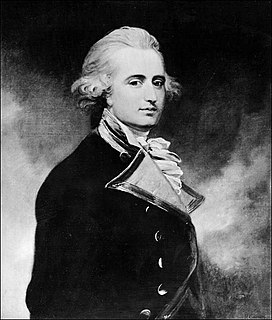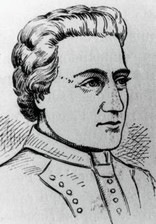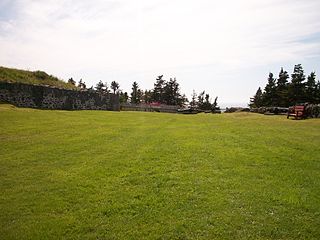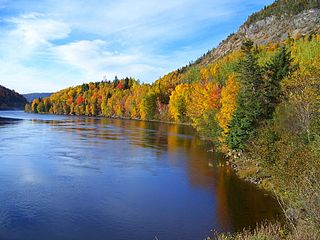
Newfoundland and Labrador is the easternmost province of Canada. Situated in the country's Atlantic region, it is composed of the insular region of Newfoundland and the continental region of Labrador to the northwest, with a combined area of 405,212 square kilometres (156,500 sq mi). In 2018, the province's population was estimated at 525,073. About 92% of the province's population lives on the island of Newfoundland, of whom more than half live on the Avalon Peninsula.

Events from the year 1747 in Canada.

Thomas Graves, 1st Baron Graves KB was a British Admiral of the Royal Navy and colonial official. He served in the Seven Years' War and the American War of Independence. He was also the Commodore-Governor of Newfoundland for a period of time.

Admiral John Montagu (1719–1795) was an English naval officer and colonial governor of Newfoundland.

Philippe Pastour de Costebelle was a naval officer and Governor of Newfoundland, born in Languedoc and died in Louisbourg.

Daniel d'Auger de Subercase naval officer and French governor of Newfoundland and later Acadia, born Orthez, Béarn died Cannes-Écluse, Île-de-France. Subercase was baptised a Protestant to Jean Dauger, a rich merchant and bourgeois who had purchased several noble estates, including the lay abbey of Subercase, near Asson.
Joseph de Monic military officer and administrator, acting Governor of Newfoundland, born Oloron, Béarn died Bayonne.
This is a chronology and timeline of the colonization of North America, with founding dates of selected European settlements. See also European colonization of the Americas.

Green Island is a rocky island in the mouth of Fortune Bay, Newfoundland. It is located about 9.5 kilometres (5.9 mi) west of the Burin Peninsula of Newfoundland and 11 kilometres (6.8 mi) east of Langlade Island in Saint-Pierre and Miquelon.
Jacques-François de Monbeton de Brouillan French military officer and Governor of Plaisance (Placentia), Newfoundland (1689-1701) and Acadia (1701-1705).
Louis de Pastour de Costebelle naval officer served as interim governor of Plaisance (Placentia), Newfoundland, before the arrival of Jacques-François de Monbeton de Brouillan in 1690. Costebelle came to Newfoundland as head of a detachment of soldiers in 1687.
Antoine Parat was Governor of Plaisance (Placentia), Newfoundland from 1685 to 1690.
The Sieur de la Palme was the Governor of Plaisance in the French colony of Newfoundland from 1667 to 1670.
Lafontaine Bellot was Governor of Plaisance (Placentia), Newfoundland from 1664 to 1667.
Nicolas Gargot de La Rochette was Governor of Plaisance (Placentia), Newfoundland in 1660. The post was left vacant until 1662.
Sieur de Kéréon was the first French Governor of Plaisance (Placentia), Newfoundland in 1655. The post was left vacant until 1660.
Thalour Du Perron was Governor of Plaisance (Placentia), Newfoundland from 1662 to 1664.

Castle Hill is an area containing the remains of both French and British fortifications, overlooking the town of Placentia in Newfoundland and Labrador, Canada. The site was originally established in order to protect the French fishing interests in Newfoundland and the approaches to the French colony of Canada.

Newfoundland is a large island off the east coast of the North American mainland, and the most populous part of the Canadian province of Newfoundland and Labrador. It has 29 percent of the province's land area. The island is separated from the Labrador Peninsula by the Strait of Belle Isle and from Cape Breton Island by the Cabot Strait. It blocks the mouth of the Saint Lawrence River, creating the Gulf of Saint Lawrence, the world's largest estuary. Newfoundland's nearest neighbour is the French overseas community of Saint-Pierre and Miquelon.

Newfoundland Colony was an English and later British colony established in 1610 on the island of the same name off the Atlantic coast of Canada, in what is now the Canadian province of Newfoundland and Labrador. This followed decades of sporadic English settlement on the island, at first seasonal rather than permanent. It was made a Crown colony in 1854 and a Dominion of the British Empire in 1907. The economy collapsed during the Great Depression and Newfoundland relinquished its dominion status, becoming once again a Crown colony, governed by appointees from the Colonial Office in Whitehall in London. American forces occupied much of the colony in World War II, and prosperity returned. In 1949 the colony voted to join Canada as the Province of Newfoundland, but in 2001 its name was officially changed to Newfoundland and Labrador.
This page is based on this
Wikipedia article Text is available under the
CC BY-SA 4.0 license; additional terms may apply.
Images, videos and audio are available under their respective licenses.











